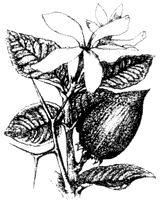
CARISSA GRANDIFLORA
SCIENTIFIC NAME: Carissa grandiflora
FAMILY: Apocynaceae

The Natal plum or Carissa grandiflora is not related to the plums of the genus Prunus in the Rosaceae family. It belongs to the family Apocynaceae, of which Oleander is also a member. Thirty species of Carissa are distributed throughout the eastern hemisphere or old world tropics.
It is a native of Natal. An evergreen shrub, it grows between 2 and 5 metres high. It has opposite thorns on the stem that branch into two sharp points. Leaves are bright green and round. The flowers are 30mm-50mm (1½" to 2") in diameter, white and fragrant. The 5 petals are twisted to the right. The bright red fruits have a paper thin skin which encloses a reddish pulp, a milky juice and from few to many small, flat, round seeds. The fruits are 25mm-50mm (1" to 2") long or almost round, depending on varieties.
Fruits are eaten out-of-hand, stewed in a sauce, resembling cranberry sauce in flavour or made into jellies, syrup or pies.
It is not fussy about soil type, growing on a wide variety of soils from beach sand to heavy clay. In fact, it is very tolerant of seacoast conditions, withstanding salt sprays. It does have a cold tolerance problem and areas with prolonged temperatures below -5°C (24°F) will damage the plant and reduce fruiting.
Natal plums can be pruned into a hedge, but it will not produce as much fruit that way. The plant has few pests and diseases. To ensure good fruiting, however, it is necessary to plant more than 1 plant. The fruit is low in calories, high in vitamin C and high in phosphorus and potassium.
It can be propagated by seeds or cuttings. Semi-hardwood cuttings root readily in sand or vermiculite. Hardwood cuttings of larger wood root more slowly. Cuttings should be 100mm to 150mm (4" to 6") long and have one or two pairs of leaves. Bottom heat and mist spray are beneficial and hasten rooting.
Layering is very successful, as is budding using the same method as grafting citrus. Make a T incision in the bark, cut a shield-shaped piece containing a bud and insert under the T incision. Wrap tightly with plastic budding tape leaving the bud exposed so that the tape will not hinder the bud's growth.
Grafting is also successful using a whip graft, however, it grows so successfully on its own roots from cuttings that it is grown more commonly this way.
(Illustration from Complete Book of Fruit, by Leslie Johns and Violet Stevenson.)
DATE: March 1987
* * * * * * * * * * * * *
